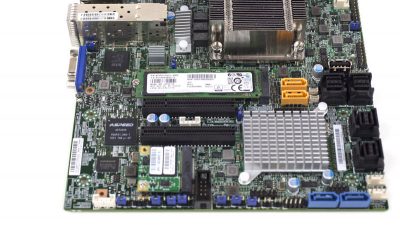FreeNAS is a FreeBSD based storage platform that utilizes ZFS. The fact that it uses a thoroughly enterprise file system and it is free means that it is extremely popular among IT professionals who are on constrained budgets. At STH we test hundreds of hardware combinations each year. From this experience, we are going to keep a running log of the best FreeNAS drives. We are going to focus this guide on FreeNAS servers with under 30 storage devices and will periodically update the listing.
Like most ZFS systems, the real speed comes from caching. ZFS is designed to make effective use of RAM and solid state drives for caching. Here are our top picks for L2ARC Drives for FreeNAS.
As a quick note, we are going to be updating this for TrueNAS Core in the near future.
L2ARC Drives for FreeNAS
L2ARC devices are a tier of storage between your ARC (RAM) and disk storage pools for reads. At today’s prices, our advice is to just get a SSD. Given that 960GB SSDs with power loss protection are well under $300, our advice: get a data center oriented drive, used. You can also skip guides that suggest 120GB or 240GB drives. While you may not need that much space, performance on smaller capacity drives suffers. 400GB should be your minimum capacity.
Another aspect to this is that you do not necessarily need power loss protection on an L2ARC drive as it is used as a read cache. You can also do without redundancy, especially if you can tolerate downtime to replace a failed device.
Our advice in 2018: Get plenty of RAM, then get a 512GB class NVMe SSD or larger. We have some legacy recommendations. At under $150, the 500GB Samsung 970 EVO is our current top pick on a price/ performance basis, with less expensive options for smaller capacities.
If you can afford a bit more, the Samsung 970 Pro 512GB is under $200 and also has a 1TB M.2 capacity available.
For larger systems with plenty of RAM that want to go over 1TB L2ARC capacity with a high-quality enterprise-class drive, the Intel DC P3600 1.6TB drives are generally inexpensive and awesome. You can also carve up a portion for an NVMe SSD storage pool, then use the rest for L2ARC effectively utilizing add-in card slots. A good source for these is ebay.
Legacy FreeNAS L2ARC Recommendations
Here are our previous picks for L2ARC drives that include SATA options if you are searching for older hardware:

- Samsung PM951 m.2 NVMe or 950 EVO 512GB (under $200 on ebay)
- Toshiba XG3 512GB m.2 NVMe SSD ($200-240 on ebay)
- Intel DC S3610 400GB, 480GB (around $200 on ebay)
- Intel DC S3500 480GB, 600GB, 800GB ($160 to $300 on ebay)
- Samsung PM863 960GB ($235- 295 on ebay)
Realistically most SSDs will be fine. FreeNAS defaults to filling L2ARC drives at around 5MB/s. If you have a 480GB drive using default settings FreeNAS will not write to a L2ARC drive fast enough to perform a full drive write per day.
The Toshiba and Samsung NVMe drives are cost-effective NVMe drives. They do not have power loss protection but they are faster than three or more SATA SSDs. The Intel 750 NVMe SSD also is a great option but pricing tend to be higher and it is not available in an M.2 form factor. If you are using 1GbE networking, you can generally skip NVMe drives as you will be bottlenecked by network bandwidth instead. If you do not have a m.2 SSD slot in your system, other good options are the Intel 750 400GB 800GB or 1.2TB NVMe SSDs.
An Intel DC S3610 is overkill as are most drives on the list. They do use a faster controller than the Intel DC S3500 so for a de minimis premium, get the Intel DC S3610. The Intel DC S3500’s are still great drives and can be purchased for around $0.25/GB. Likewise, the Samsung PM863 drives are very popular with OEMs such as HPE and thus are extremely inexpensive. Given most L2ARC usage in this class of ZFS server is light, solid capacity is fine.
Final Words
Given most L2ARC usage in this class of ZFS server, do not spend over $300-350 for a L2ARC drive. Used data center SSDs we have found to be both reliable and very low wear from actual use. See our work here: Used enterprise SSDs: Dissecting our production SSD population. Save money over consumer-grade SSDs and get larger/ more drives with power loss protection. At the end of the day though, just about any SSD is a good option and there are folks who successfully use USB 3.0 thumb drives as L2ARC devices in ZFS NAS proof of concept systems.
These days, we strongly suggest using a NVMe L2ARC drive if possible. They have come down in price to the point where if you have an open slot, it can make a great upgrade for a hard drive array.
You can see more of our FreeNAS Buyer’s Guides here.
Last updated 2019/07/30
